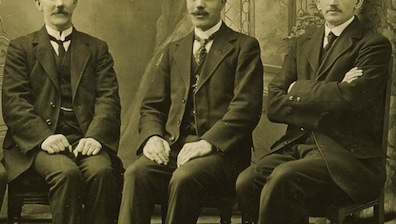At several points in the novel, men reach out to Stephen in
efforts to guide him—often literally, with a touch. In his
obvious brilliance and obvious lostness Stephen attracts
paternal feelings, and, in this epic of the human body, that
need for human connection often registers in physical touch,
just as it does in Stephen's need for a heterosexual
relationship. But not all of these overtures are welcome, and
at least one makes him wonder whether the other man has
homosexual designs on him. This apprehension colors his
responses to Leopold Bloom, who charitably, and physically,
assists Stephen at the end of Circe and again near the
end of Eumaeus. In the first case, Stephen's
apprehension is conveyed by seeing Bloom as a vampire. In the
second, a New Testament condemnation of homosexuality lurks in
his impression of "a strange kind of flesh of a different
man."
In Proteus, Stephen imagines meeting a woman who
can rescue him from his loneliness: "Touch me.
Soft eyes. Soft soft soft hand. I am lonely here. O, touch me
soon, now. What is that word known to all men? I am quiet here
alone. Sad too. Touch, touch me." When Nora Barnacle rescued
James Joyce on that same stretch of beach, she touched him in a quite
intimate way. Joyce has both Bloom and his wife Molly remember
how
magical touch can be for people first entering a sexual
relationship.
Mulligan's offer of intimate, but certainly not overtly
sexual, friendship is represented in Telemachus when
he locks arms with Stephen and holds him for a prolonged time:
"Buck Mulligan suddenly linked his arm in Stephen's
and walked with him round the tower." Twelve
paragraphs (or fully a page) later, readers learn that "Stephen
freed his arm quietly." The verb "freed"
suggests an aversive response, and Stephen's memory of Cranly
a little before this—"Cranly's arm. His arm"—shows him
associating this new friendship with one that carried homoerotic
overtones in A Portrait. Stephen distrusts
Mulligan's efforts to become his mentor ("I'm the only one
that knows what you are. Why don't you trust me more?"), and
he seems to detect a predatory sexuality in the offer to take
control of his life. In Scylla and Charybdis, after
Mulligan rhapsodizes about "the charge of pederasty brought
against the bard," Stephen thinks, "Catamite."
In Nestor the old headmaster Mr. Deasy never
touches his employee (although he does come running after him
down the front path), but he brims with presumptuous advice
that Stephen clearly has no intention of following. The
pattern is repeated in Aeolus when the newspaper
editor Myles Crawford lays “a nervous hand on
Stephen’s shoulder”—nervous because he wants to
recruit him to write for the paper. Like Mulligan, Crawford
presumes to understand the reserved young writer: “You
can do it. I see it in your face.” But his presumption prompts
a hostile response from Stephen, who links Crawford with
Father Dolan, the demented Jesuit disciplinarian who punished
him unjustly in A Portrait: “See it in your face.
See it in your eye. Lazy idle little schemer.”
Wandering Rocks shows a man's touch that does not
create apprehension in Stephen. Almidano Artifoni resembles
Mulligan and Crawford in presuming to understand the younger
man: Stephen is wasting his singing talent, he says, when he
could be earning some money from it. But on this occasion
Stephen listens gratefully to the advice and accepts his
teacher's touch without any evident unease: "His heavy
hand took Stephen's firmly. Human eyes. They gazed
curiously an instant and turned quickly towards a Dalkey
tram."
All of these touches from older men serve as preambles to the
long-delayed meeting of Stephen and Bloom in the final
chapters of Ulysses. After being knocked unconscious
by a British soldier at the end of Circe, Stephen
groggily comes to and sees Bloom solicitously hovering over
him and calling his name: "Who? Black panther. Vampire."
His apparent
impression that Bloom is a vampire makes sense, as the
man is dressed all in black and bending over him as if to bite
his neck. But Stephen has strongly associated vampirism with
sexuality in Proteus and in Circe (as had
everyone else since the appearance of Bram Stoker's novel),
and in Scylla and Charybdis Mulligan has warned him
that Bloom is "Greeker than the Greeks": "O, Kinch, thou art
in peril. Get thee a breechpad." (The black panther
association apparently stems from seeing the "dark back" of
this man exit the library ahead of them, with the "step of a
pard.")
Eumaeus shows Bloom, like Artifoni, advising Stephen
to take advantage of his talent as a singer. This happens
shortly after he ushers him out of the cabman's shelter and
starts leading him home to Eccles Street, saying "It's not
far. Lean on me" and, like Mulligan on top of the tower,
linking "his left arm in Stephen's right." Stephen says "Yes"
to the invitation, but “uncertainly, because he
thought he felt a strange kind of flesh of a different man
approach him, sinewless and wobbly and all that."
The uncertainty seems, at first glance, to derive simply from
Stephen becoming aware of Bloom's unprepossessing physicality:
touching him reveals that he is "sinewless and wobbly." What
inebriated, exhausted, and battered individual would want to
lean on that kind of a guide?
But there is more to it than that. In his patented allusive
manner Joyce includes in the description of Stephen's response
to Bloom two words that evoke a passage in another literary
text. The short epistle of Jude, which comes just before
Revelation in the Christian Bible, warns against "certain men"
who have "crept in unawares" to the Christian community,
"ungodly men, turning the grace of our God into
lasciviousness" (1:4). Jude reminds his readers of how God led
his chosen people out of Egypt but later destroyed some who
did not believe in Him, and how He cast down the rebel angels,
"Even as Sodom and Gomorrha, and the cities about them in like
manner, giving themselves over to fornication, and going
after strange flesh, are set forth for an example,
suffering the vengeance of eternal fire. Likewise also these
filthy dreamers defile the flesh, despise dominion, and speak
evil of dignities" (1:7-8).
One can perhaps detect in this allusion an echo of Stephen's
Christian apprehension about entrusting himself to the helping
hand of a Jew––an anxiety that he will acknowledge in the next
chapter when he chants for Bloom's edification the antisemitic
ballad of little Harry Hughes. But if that worry is implied,
it is only as a faint overtone to the main note of homophobia.
Bloom's flesh is strange not only because he is a bit flabby
but also because Stephen's radar is set on high gain for older
men with designs on him, sexual or otherwise. Nowhere does the
novel suggest that Bloom has any sexual interest in Stephen,
though it does suggest that he has a moderately creepy
interest in hooking him up with Molly and/or Milly. But after
Mulligan's warning Stephen may very well be thinking this
about Bloom.
A final wrinkle: if Eumaeus is narrated from
something very like Bloom's point of view, then may it
not also be possible that Bloom intuits this sexual
apprehension in Stephen? It is inconceivable that he knows the
Christian Bible well enough to recall Jude's condemnation of
men "going after strange flesh"––that knowledge could
only come from Stephen or from Joyce––but the language about "sinewless
and wobbly" flesh could well be a projection of Bloom's
unconfident consciousness. Since the prose style of the
chapter hovers very close to that consciousness, it is
conceivable that Bloom is feeling apologetic about his poor
physical condition and at the same time dimly aware that
Stephen might distrust him for another reason.


